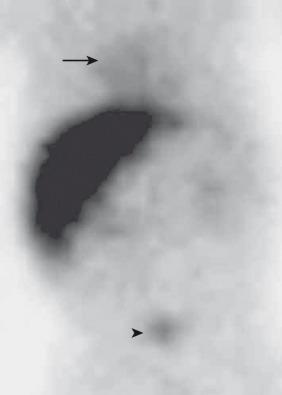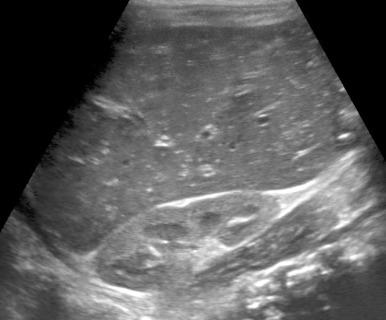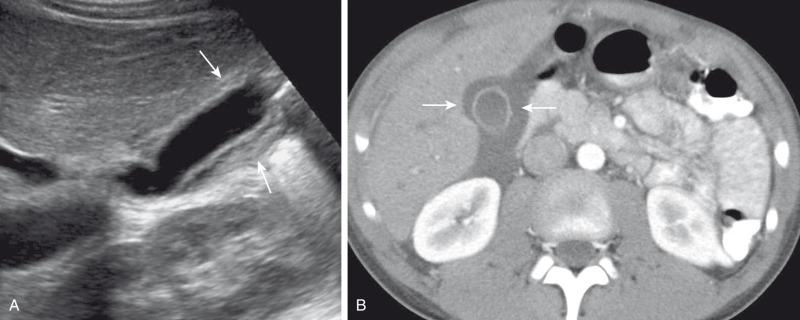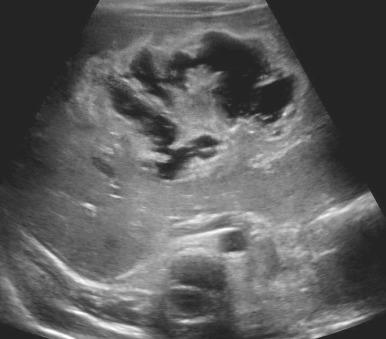Physical Address
304 North Cardinal St.
Dorchester Center, MA 02124
A wide range of viruses, bacteria, fungi, and parasites can infect the liver. The liver can be the primary organ of infection (as seen with viral hepatitis), or the liver can be secondarily involved as part of a systemic infection (such as with bacterial or fungal infections). The agents can cause a wide range of disease, ranging from subclinical infection, jaundice and cholestasis, diffuse hepatitis, microabscesses, focal abscess, or necrosis. Immunocompromised patients are affected differently than immunocompetent patients.
Viral hepatitis presents a spectrum of clinical severity, which can range from subclinical infections to fulminant hepatitis with further evolution to cirrhosis.
In the neonatal period and in early infancy, patients are more likely to show signs and symptoms from viruses that cause perinatal and congenital infections, such as cytomegalovirus (CMV), herpes simplex virus (HSV), rubella virus, and parvovirus rather than the hepatotropic viruses. They can become seriously ill with hepatitis and present with massive hepatocellular necrosis. It is important in these infants to exclude biliary atresia as a cause for cholestasis.
In childhood, viral hepatitis is most commonly caused by the hepatitis A, hepatitis B, and hepatitis C viruses, which are viruses that target the liver. A number of other viruses have been implicated in childhood hepatitis, including mumps, measles, varicella-zoster virus, HSV, CMV, adenovirus, Coxsackie virus, and Epstein–Barr virus (EBV). These viruses cause systemic or disseminated illness, with hepatitis a part of the illness.
Most affected patients have a short-lived acute disease with complete recovery. Complications include subacute and chronic active hepatitis, evolution into cirrhosis, and development of hepatocellular carcinoma. Chronic hepatitis B and C viral infections are linked directly to hepatocellular carcinoma development.
Nuclear scintigraphy may be performed in infants with cholestasis to differentiate biliary atresia from other causes, collectively known as neonatal hepatitis. In neonatal hepatitis, liver function is decreased, and there is poor uptake of radiopharmaceutical with delayed excretion through the biliary tree into the small bowel and vicarious excretion through the kidneys ( Fig. 90.1 ). The test has high sensitivity (98%–99%) but lower specificity (70%). More accurate specificity is obtained when using premedication with phenobarbital to induce the hepatocytes, radiotracers with higher hepatic extraction (such as trimethylbromo-iminodiacetic acid [BrIDA] and diethyl iodophenyl-carbamoylmethyl-iminodiacetic acid [IODIDA]), dosing by body weight, and use of booster doses.

In children and adults, diagnosis of a viral hepatitis infection is made clinically and on the basis of laboratory data. If imaging is performed during the acute phase of the illness, the liver may be enlarged or normal in size. On ultrasound (US), the liver echotexture may be normal or sonography may demonstrate increased parenchymal echogenicity and heterogeneity. The “starry sky” pattern describes an edematous liver that is diffusely hypoechoic, allowing the portal triads and portal venous walls to appear bright; this imaging finding has limited sensitivity and specificity, and may be present in other forms of liver disease other than viral hepatitis ( Fig. 90.2 ). Computed tomography (CT) scans may show heterogeneous changes in attenuation but more commonly show hepatomegaly, gallbladder wall thickening, and periportal low attenuation ( Fig. 90.3 ).


If the course of the viral infection progresses to hepatocellular necrosis, the areas of necrosis can mimic pyogenic microabscesses or diffuse hypoattenuating nodules on contrast-enhanced CT, as in reported cases of fulminant herpes-simplex virus hepatitis.
In patients with fulminant hepatitis and subsequent hepatic regeneration, imaging differences have been described between necrotic areas and regenerating nodules. Regions of necrosis have central low attenuation on precontrast CT relative to regions of regeneration. After intravenous contrast administration, areas of necrosis and regeneration may enhance similarly such that they become indistinguishable, or the regenerating nodules may show hyperenhancement, which can simulate a neoplastic lesion. Similarly, magnetic resonance (MR) imaging may show nonspecific periportal high intensity on T2-weighted images and hepatomegaly. On MR, areas of nodular regeneration show high signal on T1- and low signal on T2-weighted images relative to adjacent necrotic parenchyma.
Measuring liver stiffness with US and MR elastography techniques is proving useful for detecting development of liver fibrosis and cirrhosis associated with hepatitis B and C infection. Children have special considerations, as the liver stiffness changes over normal development from childhood to adolescence to adulthood, as demonstrated on MR elastography.
Treatment of viral hepatitis varies from symptomatic treatment to antiviral medication or transplant depending on the type and severity of the disease. Fulminant hepatitis may be fatal without hepatic transplant.
Bacterial infections of the liver have a wide range of manifestations, including cholestatic jaundice, hepatitis, hepatomegaly, abscess formation, and fulminant hepatic necrosis. Many of the bacterial infections that have liver involvement do not require the aid of imaging for diagnosis and treatment, and lack specific imaging findings. Patients with prolonged fever without a source or patients with unexplained hepatomegaly often come to imaging for assistance in identifying the source of infection, and liver findings, such as identification of complications such as abscess, can aid in the diagnosis.
Because of the wide range of bacteria that can cause infection with liver involvement, identification of the specific organism causing the patients' symptoms is the key to diagnosis and treatment. Table 90.1 lists prominent bacterial infections that involve the liver, including spirochetes, rickettsial organisms, and tuberculosis.
| Disease | Causative Organism | Patient Population | Liver Disease Manifestations |
|---|---|---|---|
| Sepsis syndrome with cholestatic jaundice | Gram positive organisms (Staphylococcus aureus, Group B Streptococcus, pneumococcus) Gram negative bacteria (such as Pseudomonas , E. coli, Klebsiella ) |
Infants, children, adults | Immune response to bacterial endotoxins create cholestasis and jaundice; hepatomegaly |
| Urinary tract infection in neonates | mainly Escherichia coli; also Enterobacter, Klebsiella, Enterococcus | Neonates | Prolonged jaundice and indirect hyperbilirubinemia |
| Actinomycosis | Actinomyces israelii and other species | Mostly reported in immunocompetent adults; children with chronic granulomatous disease | Hepatic abscess formation |
| Bacille Calmette-Guerin (BCG) vaccination | Live attenuated vaccine against tuberculosis disease | Immunodeficiency disorders such as severe combined immunodeficiency (SCID) | Multiple liver lesions; enlarged lymph nodes |
| Bacillus cereus | Bacillus cereus | Immunocompetent patient; food borne illness | Fulminant hepatic failure from emetic toxin |
| Bartonellosis | B. henselae and B. quintana | Children more so than adults; bite or scratch from infected cat or infected fleas | Granulomatous lesions with microabscesses; can calcify late |
| Brucellosis | Brucella | Humans in contact with infected animals or their products | Hepatic abscess (necrotizing granuloma), possible calcification |
| Listeriosis | Listeria monocytogenes | Fetal infection; immunocompetent and immunocompromised | Abscesses or granulomas in fetal infections (part of granulomatosis infantiseptica) Hepatitis; solitary abscess; multiple liver abscesses (in adults) |
| Leptospirosis (spirochete) | Leptospira species | Children exposed to infected animals, contaminated soil or water | Fever and jaundice; can lead to liver failure (Weil disease) |
| Lyme disease (spirochete) | Borrelia burgdorferi | Tick bite | Subclinical hepatitis, abnormal liver function tests, hepatomegaly |
| Nocardiosis | Nocardia species | Immunocompromised patients especially with chronic granulomatous disease; some immunocompetent patients | Mainly pulmonary and CNS disease; hematogenously disseminated disease affects liver |
| Q fever (Rickettsia) | Coxiella burnetii | Children and adults exposed to infected animals and drinking raw milk | Hepatomegaly, jaundice and granulomatous hepatitis; fibrosis and cirrhosis in chronic form |
| Rocky Mountain spotted fever | Rickettsia rickettsia | Tick bite | Jaundice, elevation of liver function tests |
| Syphillis (spirochete) | Treponema pallidum | Fetal infection; neonatal and congenital infection | Cholestasis, hepatosplenomegaly, ascites, intrahepatic calcifications |
| Tuberculosis | Mycobacterium tuberculosis | Miliary dissemination with caseating granulomas and hepatomegaly; focal or nodular tuberculosis; hepatic abscess; enlarged lymph nodes |
Neonates are at risk for sepsis, jaundice with a urinary tract infection, and disseminated listeriosis and syphilis. Patients with immune deficiency such as chronic granulomatous disease have special considerations such as infections with actinomycosis and nocardiosis. Important to note is a history of animal exposure, especially in the case of bartonellosis, leptospirosis, and Q fever, or tick exposure with Lyme disease or Rocky Mountain spotted fever.
In neonates, common bacterial pathogens causing liver abscess are Staphylococcus aureus, Streptococcus pyogenes, and Escherichia coli . Other organisms such as Klebsiella and Pseudomonas have been identified, as well as fungal species like Candida albicans . Up to half of the reported abscesses are polymicrobial.
In neonates, hepatic abscess are rarely reported, but risk factors include prematurity, umbilical vein catheterization, sepsis, total parenteral nutrition, and necrotizing enterocolitis ( Fig. 90.4 ). Worldwide, liver abscess in children is more frequent in developing countries than in developed countries. Risk factors include intraabdominal infection such as perforated appendicitis and inflammatory bowel disease such as ulcerative colitis. Immunocompromised patients are at particularly high risk for liver abscesses, and the risks include acquired immunodeficiency such as with chemotherapy and bone marrow transplantation, and congenital immunodeficiency like chronic granulomatous disease.

The most common bacterial cause of liver abscess in children is S. aureus; the most common parasitic cause is Entamoeba histolytica . In endemic areas, tuberculosis is a significant cause of liver abscess, regardless of the presence or absence of active disease elsewhere. The occurrence of multiple hepatic abscesses in a child should raise concern for underlying immunodeficiency.
Become a Clinical Tree membership for Full access and enjoy Unlimited articles
If you are a member. Log in here